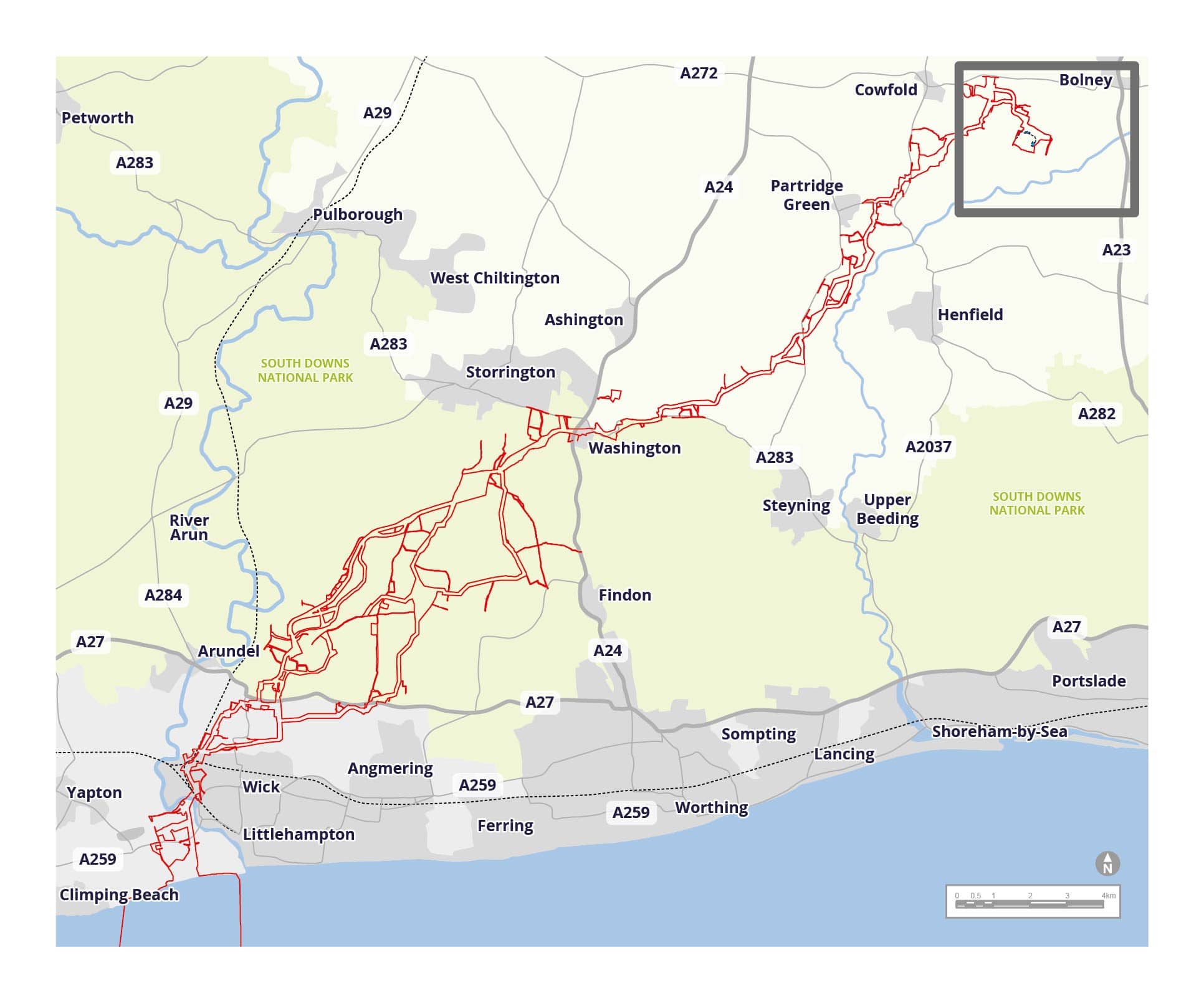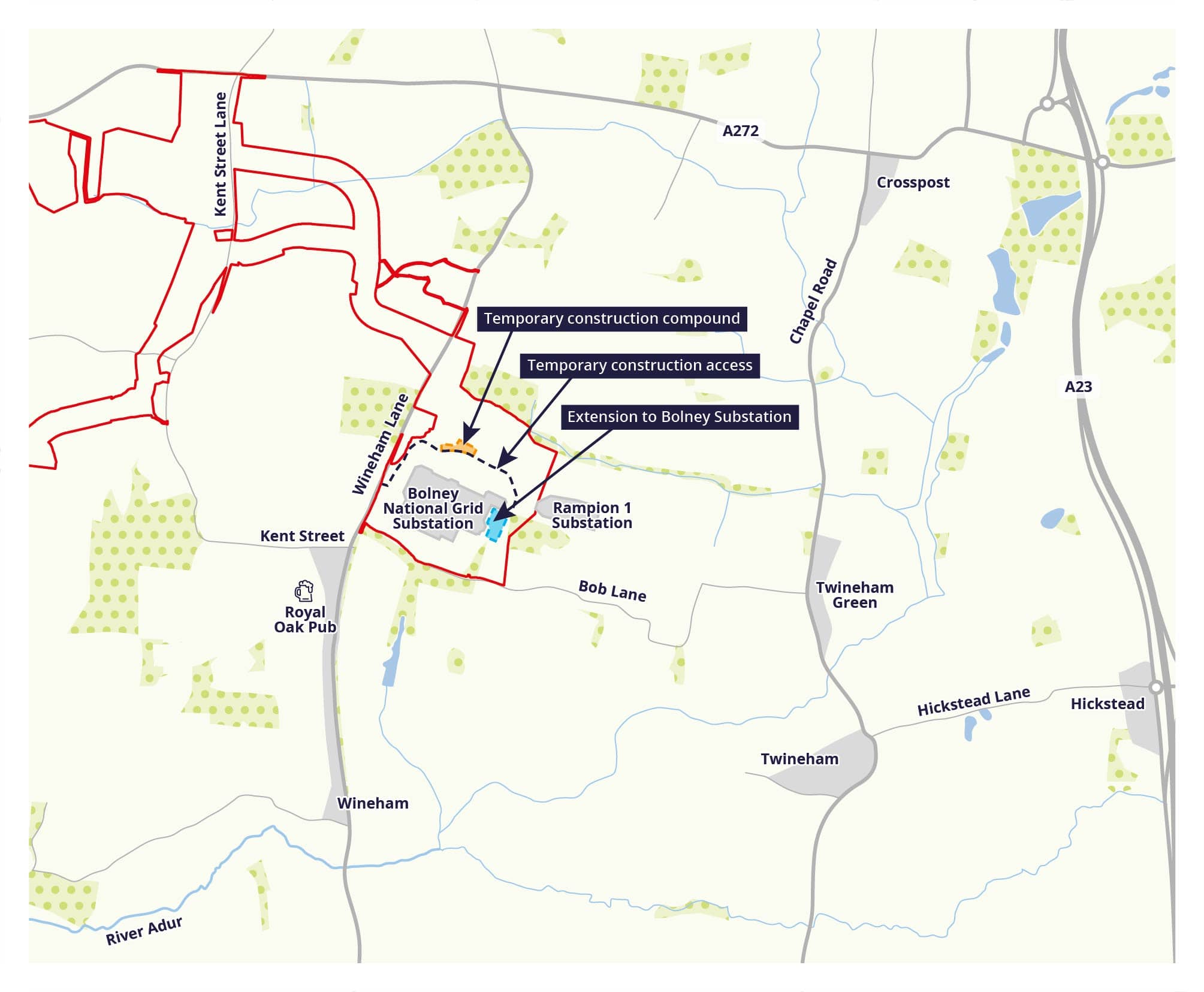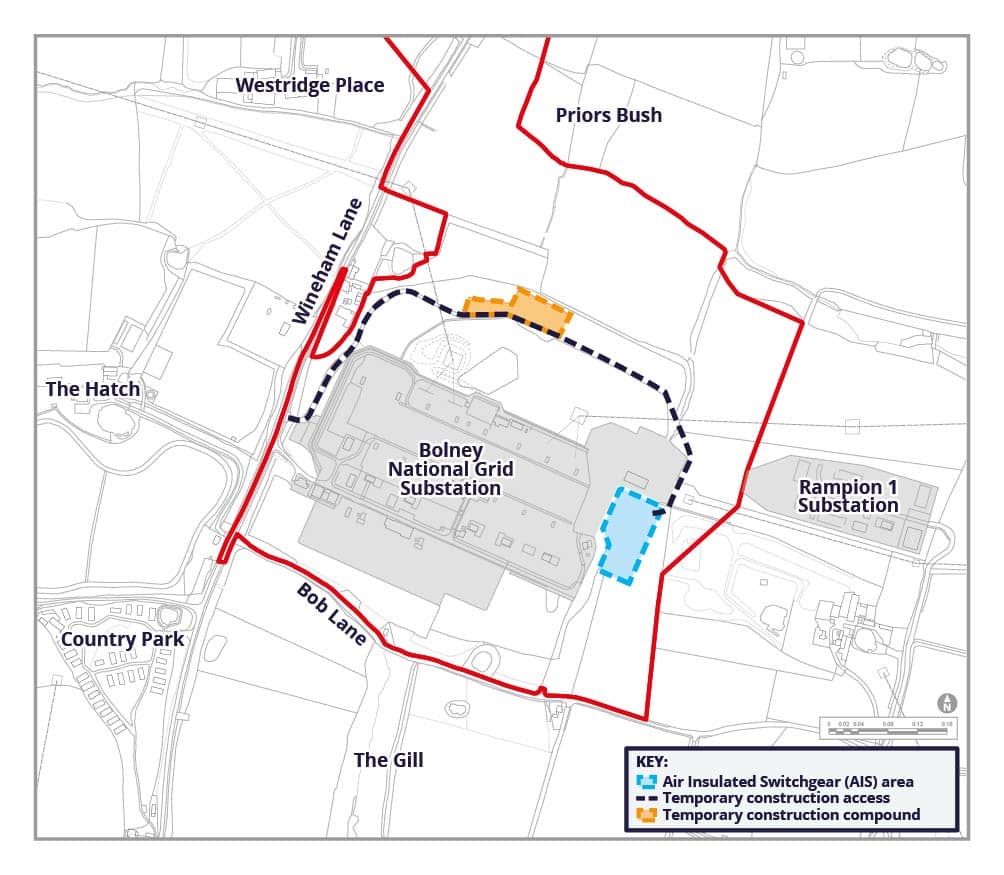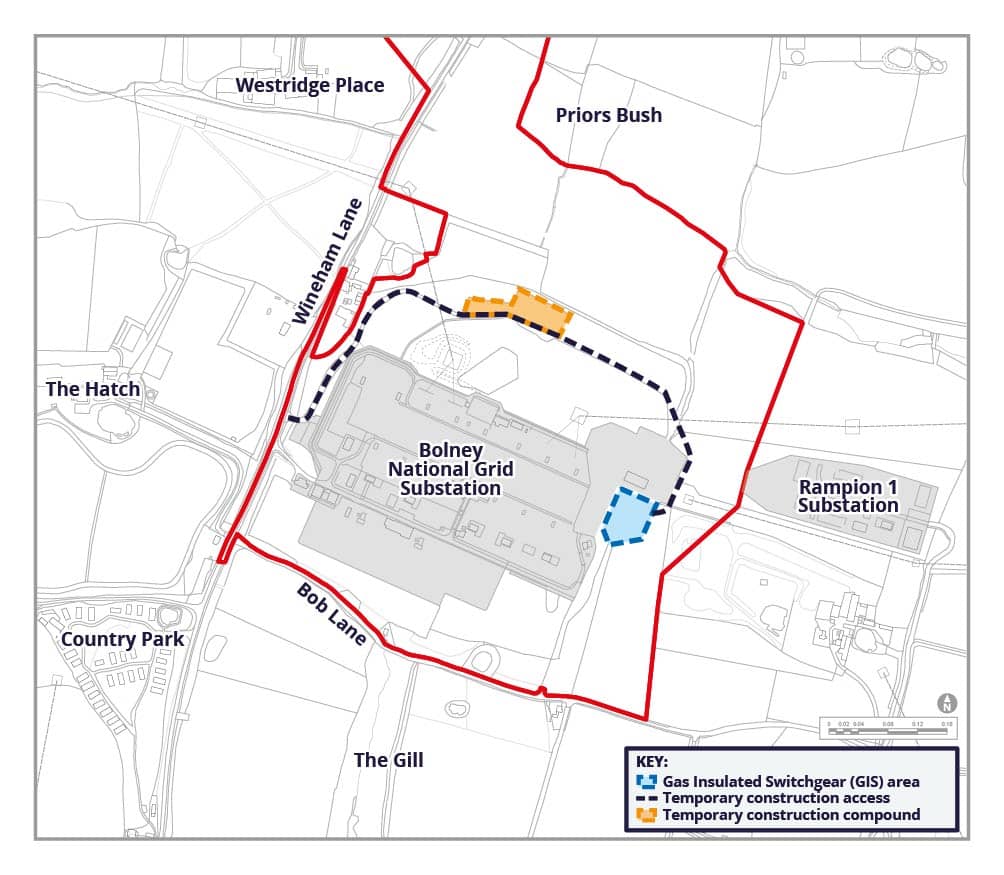Consultation Proposals
This targeted consultation presents proposals for a comparably small extension to the existing National Grid Bolney substation, close to Wineham village and located in the Parish of Twineham. This would be required to connect the power from our Rampion 2 wind farm into the National Grid, so that it can be used by homes and businesses.
Table of Contents

Introduction to this Consultation
This consultation is limited to our proposals at the National Grid Bolney substation, at the very end of our onshore cable route. Effectively this extension would create the “socket” to enable the electricity generated by the wind farm to be “plugged” into the National Grid. This is separate from our proposed project substation at Oakendene. The Bolney substation needs to be extended by around 0.6ha for infrastructure to enable this connection, representing up to a 6% increase to the existing National Grid site area.
Here you will find a description of the proposal, its location and a summary of its likely environmental effects. You can respond based on this, or you can read more in our technical documents. This includes more detailed information about potential environmental effects associated with this proposal.
The proposed substation extension is the focus of this consultation. All feedback received will be considered alongside the feedback already received during previous consultations. This will help us form our final proposals, which we will submit in our consent application in summer 2023.
We use some technical terminology in the remainder of this consultation. Please do read the ‘definitions’ at the bottom of this page if this helps.
Why this work is necessary
Our proposed offshore wind farm could generate up to 1,200 megawatts, enough to power over 1 million homes, meaning Rampion and Rampion 2 combined will be able to power all of the homes in Sussex, twice over. This power is to be carried onshore by buried cables and would be transformed to national electricity network voltage (400kV) at our project substation at Oakendene, with further cables connecting the Oakendene substation to the National Grid Bolney substation; these elements have already been consulted upon. Connecting into the National Grid Bolney substation allows the power we generate to be transmitted onwards to the people that use it. To do this we have confirmed with National Grid that additional infrastructure would be required, being the subject of this consultation.
Proposals for consultation
We are proposing a comparably small extension to the existing National Grid Bolney substation. The extension to the site, and the infrastructure installed would be permanent. We are consulting on extending the fenced site by up to 0.65ha (about 1.6 acres), into land already owned by National Grid. Our proposed location would be on the south-eastern edge of the existing site, near an area of woodland.
Within this new location, there are two possible electrical designs for the substation extension. National Grid will decide which design is best, considering the needs of the wider substation and legal requirements that they have to follow. We will seek planning consent for both options, so that the decision can be made nearer to the date of construction. The technology options for the connection use either Air Insulated Switchgear (AIS), where the main electrical equipment would be visible outside and would require a larger area, or Gas Insulated Switchgear (GIS), which would be housed within a building but require a smaller area.
An AIS connection would look similar to most of the existing Bolney substation, with electrical equipment up to 12m high. Existing busbars (used to transmit electricity) within the National Grid site would be extended eastwards into the new area. This option uses a larger area of land, up to 0.65ha, increasing the substation area by 6%.
For GIS we would create an enclosed building for switchgear. Detailed design would be carried out at a later date, but we are expecting a building with maximum dimensions of 35metres (m) x 20m, and 12m tall. This would be similar to the other large buildings on the existing National Grid site. Existing busbars (used to transmit electricity) within the National Grid site would be extended up to our new building. This option would use less land, around 0.35ha, only increasing the substation footprint by 3%.
In both cases, the new buried cables bringing power from our Oakendene substation would be connected to the proposed National Grid extension on the east side. The substation perimeter fence would then need to be extended securely around this infrastructure to create a single site.
Construction and access
Construction would take a maximum of 12 months and would be subject to the same normal working hours as the rest of our project (07:00-19:00 Monday to Friday and 08:00-13:00 on Saturdays). We would set up a construction compound nearby, likely just to the north of the existing substation on National Grid land currently used as hardstanding.
Construction vehicles would use the existing access to the National Grid Bolney substation, and drive around the existing site to reach our works. Construction traffic would reach Bolney substation from the main road network via the A272 and Wineham Lane, like our other works in the vicinity. Monthly inspections and any future maintenance would be from within the National Grid Bolney site.
Environmental mitigation
The environmental mitigations that we have already committed in our Code of Construction Practice would also apply here, including traffic management and restrictions on working hours (as set out above), construction noise and lighting.
We think that the extension location would be well screened by existing vegetation and we have produced visualisations of how the substation extension would fit in the landscape here. However, there is the opportunity to plant more if required, such as to screen views from Bob Lane to the south. Details of layout, appearance and landscaping are usually agreed with the local planning authority prior to construction. We welcome opinions on visual screening as part of the consultation.
Potential environmental impacts
The proposed substation extension would lie entirely within the project boundary that was considered in our Preliminary Environmental Information Report. We don’t think that this work would cause any additional likely significant effects on the environment, nor would it affect any additional sensitive receptors beyond those previously reported.
There are no public rights of way within the construction or operational area, and our earlier conclusion of effects on users is therefore unchanged. The proposed site is already well screened from views in, and we would commit to further planting to mitigate landscape effects as required. There are no sensitive receptors or likely significant effects beyond those previously reported.
The additional works would generate additional construction traffic, but given the relatively small scale of the works, this wouldn’t change the assessment conclusions in the PEIR Supplementary Information Report. The same applies to our appraisals of air quality and noise and vibration, for which no new receptors are identified and there is no change to our previous assessment conclusions. The operational noise of the proposed switchgear is unlikely to be audible outside of the substation boundary and is thus not significant.
Our proposed site is not part of a priority habitat inventory or otherwise protected for ecology, and the construction compound would be on existing hardstanding. No new terrestrial ecology receptors are identified, and it would not result in a change to our assessment conclusions in the PEIR.
The additional permanent development proposed would increase the overall permanent land use area of the project, but this extent is not significant and does not change our earlier conclusions regarding effects on soils and agriculture. Development near the existing Bolney substation has the potential for ground contamination, but this has already been assessed in our PEIR. The additional area of hardstanding proposed for the substation extension would need to be accounted for in the drainage strategy, but the scale required would not affect the conclusions of the PEIR.
We think that prior ground disturbance would have reduced the potential for surviving buried archaeology, and visual screening reduces the potential for impacts on the setting of listed buildings and other heritage assets. There would be no additional receptors and no change to the PEIR assessment conclusions.
Considering the implementation of embedded environmental mitigation measures, we don’t think that the extension of the Bolney substation as proposed would result in any additional receptors or likely significant environmental effects beyond those already assessed.
Technical Consultation Documents
Previously Published
Definitions
National Grid Bolney substation / Bolney substation:
National Grid owned and operated 400 kilovolt substation located just north of Bob Lane and east of Wineham Lane in the parish of Twineham.
Project substation / Oakendene substation:
Rampion 2’s proposed onshore substation south of the A272 and west of Kent Street, required to transform the power up to 400kV to enable connection into the National Grid Bolney substation.
Substation Extension:
A small extension to the existing Bolney substation, on the east side, providing a ‘socket’ from which to ‘plug’ into the Bolney substation – also the subject of this consultation.
AIS (Air Insulated Switchgear):
Air Insulated Switchgear (AIS), where the main electrical equipment would be visible outside and would require a larger area.
GIS (Gas Insulated Switchgear):
Gas Insulated Switchgear (GIS), where the main electrical equipment would be housed within a building but require a smaller area.
Cable route:
The route for our electricity cables from the landfall to the Bolney substation, via our own onshore project substation. The cables would be laid underground over a normal construction width of 50m, including our temporary construction works and the 20m permanent space we need for cables.
Receptors:
Something that could be affected by our works, for example, a property or nature conservation site that might hear construction noise. We identify receptors to understand the potential effect of our project.
Consent application / Development Consent Order (DCO) application:
The DCO application will include our final proposals (onshore and offshore), Environmental Statement (setting out potential impacts and intended mitigations), Consultation Report (setting out consultation feedback and how we took it into account) and Book of Reference (maps and details of land ownership). These are submitted to the Planning Inspectorate for examination.
Outline Code of Construction Practice (CoCP):
Sets out the approach to how construction activities will be managed and controlled, in order to deliver the commitments and mitigation arising from the onshore elements of the project.
Preliminary Environmental Information Report (PEIR):
Our initial assessment of the original project, consulted on in summer 2021.
PEIR Supplementary Information Report (PEIR SIR):
Additional information on the changes that were the subject of our statutory onshore consultation in autumn 2022.
PEIR Further Supplementary Information Report (PEIR FSIR):
Extra information on the onshore cable route proposal that was the subject of our targeted onshore consultation in February 2023.
Construction traffic:
This could run along a dedicated access route we create, or on the local highway network.
Construction access:
Used for construction vehicles to get from the local highway network to our substation extension site and construction compound.
Operational access:
Used by vehicles to monitor the Bolney substation extension at monthly intervals, or maintain the site on occasion, as required.
Construction compound (temporary):
Provides space for laydown areas for the storage of materials, welfare facilities, parking etc. The land will be made good upon completion of works.
Preliminary Environmental Information:
Information that is reasonably required for those being consulted to develop an informed view of the likely significant environmental effects of the development.
Work Plans:
Plans prepared to show the general categories of works in the new area we are consulting on.
We want to hear from you:
We welcome views on the proposed extension to the National Grid Bolney substation, in Twineham. We will consider your feedback alongside that received from our existing consultations to help inform what we take forward to our Development Consent Order application. Please note, this consultation focusses on the National Grid substation extension only and is not revisiting any other part of the project such as the offshore elements, the onshore electricity substation at Oakendene or the onshore cable route. Please ensure that all comments are provided by 23:59 on Tuesday 30th May 2023.
To provide your feedback, please use the link below.






